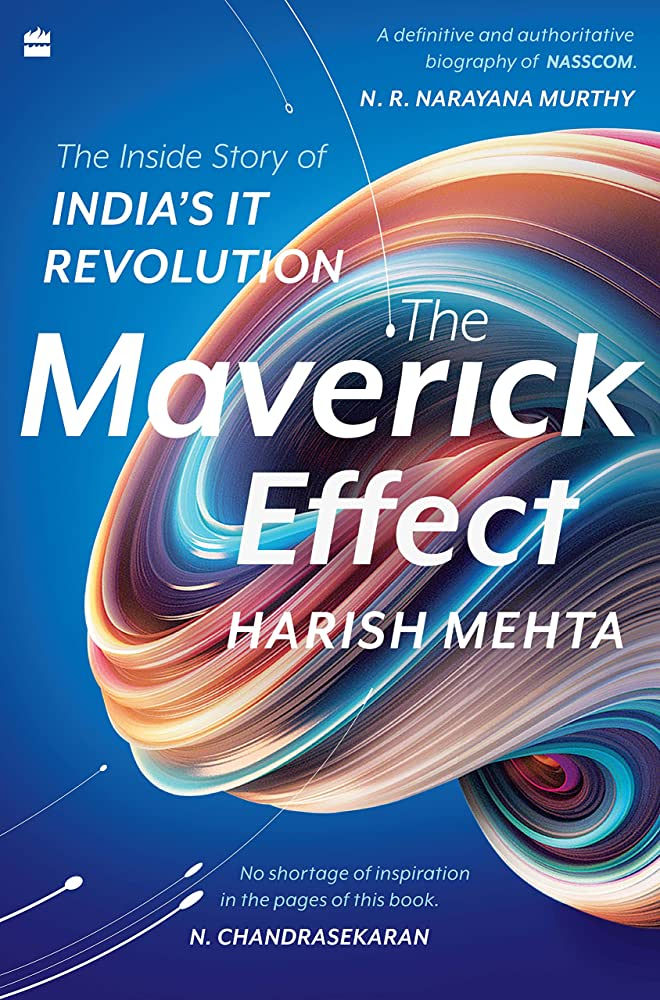The Maverick Effect: The Inside Story of a Movement that Shaped India's IT Revolution (Excerpt)
- Mr. Harish Mehta

- Apr 25, 2023
- 4 min read
Updated: May 16, 2023
by Harish Mehta, Founder and Executive Chairman of Onward Technologies Ltd and NASSCOM.

"The Maverick Effect is the extraordinary story of this band of dreamers who joined hands to transform a nation while also changing the lens through which the world looked at India. Valued at a staggering $200 billion today, the Indian IT industry directly employs more than four million people. It is the largest forex earner and has helped millions of Indians beat poverty and rise to the middle-income group. Honest, open and inspiring, Harish Mehta’s journey proves that no vision is impossible if unrelenting, kindred spirits unite."
https://harpercollins.co.in/blog/announcements/press-release/harpercollins-presents-the-maverick-effect-by-harish-mehta/
Excerpt from the Maverick Effect
Popular culture tends to paint all bureaucrats as outmoded, bribe-seeking, selfish people. In my personal experience, this was far from the truth. There were plenty of bureaucrats who genuinely wanted to make a difference. If that were not the case, they would not be entertaining our overtures, year after year without a single incident of bribery.
Our work with the government, bureaucrats and departments, ranging from the DoE and home ministry to the customs, revenue and excise departments to even institutions like the RBI and the Securities and Exchange Board of India (SEBI), ended up impacting more than 100 regulations. Some of these took more than five years of advocacy to bring about change. Such was breadth and depth of our engagement.
Boot crash
Impossible events led to the formation of NASSCOM in 1988. The odds against which it eventually came into being makes it nothing short of a miracle. But there was more to come. Wait till you hear about how the association turned the grinding wheel. The first turn was to put the right people in the right seats.
We had agreed upon a two-person leadership team. The first, the president, would be a full-time employee. The second, the chairperson would be an industry veteran who understood business challenges.
The chairperson was to be the public face of NASSCOM. This person’s stature would become NASSCOM’s stature. If we wished to equal MAIT’s credibility, we would need someone as revered as F C Kohli or Dr O P Mehra. Qualities like credibility and assertiveness were functionally crucial for this position.
Ideally, we would have Kohli himself take up office. But he had made it clear that he would continue at MAIT because he wanted to see both hardware and software industries grow in India.
I could not have held that role because I was just not senior enough. Hinditron also had a JV going on with DEC. Besides, I had suffered a heart attack the previous year.
Eventually, we approached the much-respected Prem Shivdasani, who had just retired from International Computers Indian Manufacture Ltd (ICIM) and started his own software business. ICIM was then one of the top IT companies in the country. Shivdasani had also been the founder president of MAIT. He just fit the bill.
After an initial reluctance lasting six months, Shivdasani promised to come on board, but only until formal elections were held. Once he consented, we started getting other people to join us as well. I took up the positions of vice-chairperson and treasurer. From then on, there was no looking back.
We got Anil Srivastava on board as president. Anil was an advisor to the government, and had held positions in the private sector in the domains of information and communications technology. He was articulate and wrote well; just the man we thought we needed to liaise with the government. NASSCOM was set for a good start.
Or so we thought.
We took the first stumble when we realised that Anil was not aligned with NASSCOM’s vision and mandate. We wanted NASSCOM to primarily build an ecosystem that would help software businesses thrive. That, in part, meant focusing on government policy and lobbying for the industry. The ecosystem would evolve, but in those early days, lobbying was the key to getting there. This involved meeting bureaucrats and politicians, and debating industry issues, convincing them to bring in the changes we sought. Besides, we expected Anil to set NASSCOM on the path to economic and organizational sustainability.
Anil instead enjoyed writing academic articles in newspapers and other publications. He was good at making presentations, but he lacked the entrepreneurial spirit that NASSCOM desperately needed to stay afloat. He wanted to be an evangelist, not a lobbyist.
There were other issues as well. Within a few months, the always hands-on Narayana Murthy brought to my notice that NASSCOM’s expenses were piling up alarmingly. I had remained focused on long-term issues and trusted the team with day-to-day operations. This had led to an accumulated debt of Rs 10,00,000. When I started investigating, I realised that we were running NASSCOM with the lavishness of an established business and not that of a non-profit or a start-up. Anil had even rented the fuel-guzzling Standard 2000 sedan at the association’s expense. In exasperation, I reached out to Anil and requested him to draw up a budget. He responded by sending me an article titled ‘Start-ups Don’t Have a Budget’. Thereon, things just went south, bringing our relationship with Anil to an abrupt end. Our experience with Anil gave us an important lesson in managing people and their expectations. We were probably not clear in defining the role and that probably created this mismatch. NASSCOM’s ability to deliver took a beating, and something had to be done urgently to stay afloat.
Purchase the Maverick Effect on Amazon Here: https://www.amazon.com/Maverick-Effect-Inside-Movement-Revolution/dp/9354895298 (Schumpeter Circle does not collect any payments for purchases of this book)


